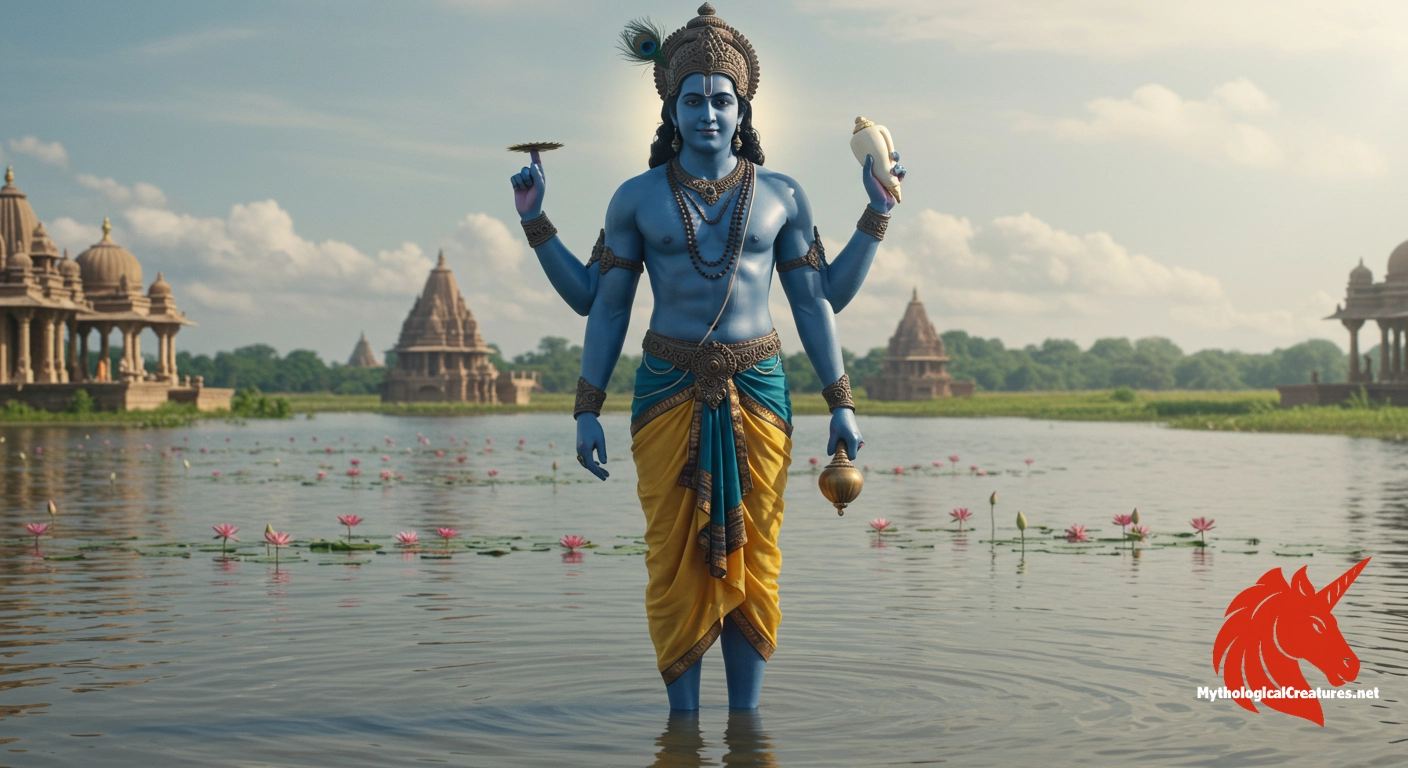Vishnu: Vishnu is a principal deity in Hinduism revered as the Preserver who upholds cosmic order and dharma.

Vishnu
Vishnu - A central deity in Vaishnavism, embodying the principles of preservation, dharma, and cosmic balance
Origins & First Encounters
Vishnu emerges as an enduring symbol of cosmic balance and order in the rich tapestry of Hindu tradition, celebrated as the Preserver among the Trimurti. His inception is deeply rooted in ancient Vedic traditions, with early hymns offering glimpses of his benevolent omnipresence. Over the centuries, his persona has been refined into that of a supreme deity who upholds dharma through his myriad forms and incarnations. Textual traditions identify him by various names such as Narayana and Hari, each echoing distinct aspects of his divine nature. His role is not only limited to the maintenance of the universe but also extends to the regeneration of life and morality whenever chaos threatens existence. The development of his mythos reflects the syncretic evolution of religious thought in South Asia and its gradual expansion into a comprehensive theological framework. Art and poetry have immortalised his deeds, encapsulating his dual temperament as both a gentle saviour and an imposing cosmic force. As a central figure in Vaishnavism, Vishnu’s narrative bridges the metaphysical with the moral, offering followers a roadmap to spiritual fulfilment. His ancient roots intertwined with later devotional practices make him a timeless figure in the collective Hindu consciousness. The legacy of his divine interventions continues to resonate, affirming his place as a guardian of cosmic equilibrium.
Source Texts & Tale Variants
The earliest references to Vishnu appear in the ancient Vedic texts, where subtle allusions prelude his later, more developed character in the Puranas and epics. His story is richly documented in texts such as the Mahabharata, Ramayana, and Vishnu Purana, each offering unique insights into his roles and responsibilities as a divine caretaker. Diverse scriptures present invigorating variations of his cosmic interventions, where his avatars are depicted as pivotal agents restoring order in times of moral and cosmic crisis. Localised folklore has further embellished his legend, imbuing his incarnations with specific regional and cultural nuances. The canonical texts often delve into his philosophical dimensions, while oral traditions contribute layers of symbolic interpretation and ritual practice. Variants of his narrative are found in devotional literature that outline how he descends to earth through his avatars to counteract the forces of chaos. Over time, commentaries and regional retellings have introduced subtle shifts in the narrative, reflecting the dynamic nature of myth in everyday spiritual life. These multiple layers of storytelling have cemented his persona as both a metaphysical force and a relatable guide to human existence. The amalgamation of scriptural evidence and folk traditions provides a multifaceted view of his powers and virtues. Such a rich corpus of sources ensures that Vishnu’s myth remains as diverse and enduring as the cultures that revere him.
Form & Powers
Vishnu is typically portrayed with a luminous, deep blue complexion that symbolises the infinite and the all-encompassing nature of the divine. His iconography frequently features four well-defined arms, each holding objects that denote authority, protection, and the power of creation. In one hand, he wields the Sudarshana Chakra—a disc known for its lethal efficacy against evil forces—while another hand carries a lotus that epitomises beauty and spiritual enlightenment. A conch shell and a mace further enrich his portrayal, reinforcing aspects of sound, energy, and strength vital to cosmic balance. His facial features are rendered with a serene composure, reflecting an inner calm and omniscience that inspire reverence among devotees. Artistic depictions portray him reclining gracefully on the eternal serpent Shesha, a symbol of time and the cyclic nature of existence. The intricate detailing of his attire and ornaments speaks to the opulence of the divine, merging form with philosophical symbolism. Subtle variations in his depictions across artworks point to the interplay between artistic expression and theological ideals. His refined features not only communicate a profound spiritual wisdom but also underline his role as the preserver of cosmic order. Each element of his physical representation, from his regal posture to his radiant countenance, has been carefully crafted to evoke awe and cosmic harmony.
Regional Faces
The portrayal of Vishnu adapts notably to the diverse cultural landscapes found throughout South Asia and beyond. In many parts of India, classical temple sculptures and paintings capture his dignified form with an emphasis on serenity, reinforcing his role as the sustainer of the universe. South Indian artistic traditions often exhibit him in elaborate poses, integrated into rich ritual and ceremonial contexts, with an emphasis on the interplay of light and divine ornamentation. In North India, his depictions might appear more narrative-driven, intricately linked to the epic tales of his avatars such as Rama and Krishna. The artistic ethos of Southeast Asia, particularly in countries like Indonesia and Thailand, incorporates local cultural motifs, resulting in vibrant renditions that fuse indigenous aesthetics with traditional Hindu symbolism. In these regions, Vishnu may appear with distinctive facial features, attire, or symbolic accessories that resonate with local sensibilities. His divine presence in Bali, for instance, is celebrated through dynamic temple festivals and iconographic styles unique to the area. Regional narratives sometimes focus on his specific avatars or selective aspects of his character, thus creating a mosaic of interpretations. The interplay between pan-Hindu iconography and local religious practices enriches his story, making it accessible and relevant. These regional variations contribute to a broader understanding of Vishnu by showcasing the adaptability of myth to different cultural idioms.
Cultural Parallels
Across the wide landscape of global mythology, Vishnu’s role as a preserver finds intriguing parallels with deities from other cultures who also embody the principles of order and renewal. Comparable figures can be discerned in the lore of ancient Greek and Norse mythologies, where gods are revered not solely for their might but also for their capacity to restore balance within the cosmos. His recurring incarnations, seen as divine interventions at times of moral crisis, echo the archetypal hero’s journey found in many world traditions. These narrative structures share striking similarities with saviour figures in other religious contexts, highlighting a universal quest for righteousness. Yet, Vishnu’s synthesis of benevolence and formidable power sets him apart, merging both martial and nurturing characteristics. The ritualistic and symbolic aspects of his iconography offer a rich field of comparison with deities in ancient Mesopotamian and Egyptian traditions. The emphasis on cyclical regeneration and cosmic duty resonates with themes observed in these diverse mythologies. Cross-cultural influences are evident in regions where Hindu ideas intermingle with local beliefs, producing hybrid forms and narratives. Such comparative analyses reveal a shared human preoccupation with maintaining order amidst chaos, while also celebrating unique spiritual insights. Ultimately, Vishnu stands as a testament to the universality of divine preservation, a concept that transcends geographical and cultural boundaries.
Legacy & Modern Evolution
The legacy of Vishnu transcends antiquity, manifesting in dynamic interpretations that reflect evolving cultural values and artistic trends. His classical images, ranging from the calm repose on Shesha to the vibrant depictions of his avatars, have profoundly influenced temple architecture, sculpture, and painting over the centuries. Modern portrayals extend beyond traditional iconography into literature, cinema, and popular media, where his narratives continue to inspire and captivate contemporary audiences. His incarnations, especially Rama and Krishna, have not only shaped religious practice but have also influenced moral and ethical discussions in modern society. The enduring symbolism of his divine interventions speaks to an unyielding commitment to justice and the perpetual struggle against disorder. With the global spread of Hindu thought, his image has become an emblem of both spiritual insight and cultural identity, resonating with diverse audiences around the world. Contemporary art often reimagines his timeless qualities through innovative media, blending age-old symbolism with modern aesthetics. His influence can also be seen in festivals and ritual practices that remain essential to community identity and cultural continuity. Debates on spirituality and morality frequently reference the balanced and compassionate nature of his character. Thus, from ancient scripture to modern digital media, Vishnu’s mystique continues to evolve, embodying a living tradition that adapts to the ever-changing contours of human civilisation.
Interesting Fact
An interesting fact about Vishnu is that his avatars span vastly different forms—from a fish to a warrior prince—demonstrating his unparalleled ability to adapt his divine essence to the needs of the cosmos.
Quick Creature Info
Associations:
Our Mythic Legendary Rating:

Also Sometimes Known As:
Habitat:
Supernatural Powers:
Physical Attributes:
Abilities:
Behavior:
Lore:
References
Discover Another Mythical Legend You May Not Have Heard Of?
Uncover the mysteries of ancient folklore and expand your knowledge of legendary beings from cultures around the world.
Dare to Meet the Undine....
Curated by the Mythological Creatures Team (rev. May 2025)
